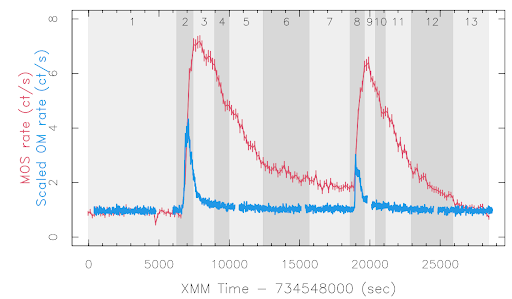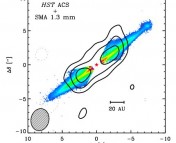Title: X-ray flares of the young planet host DS Tuc A
Authors: I. Pillitteri, C. Argiroffi, A. Maggio, G. Micela, S. Benatti, F. Reale, S. Colombo, and S.J. Wolk
First Author’s Institution: INAF-Osservatorio Astronomico di Palermo
Status: Accepted to Astronomy & Astrophysics [closed access]
The study of exoplanets, or planets orbiting stars other than our Sun, has been an exciting field of astronomy ever since the first exoplanet was discovered orbiting a type of neutron star called a pulsar. By studying exoplanets, astronomers can learn about how planets form around stars and the interplay between the two that we may not see in our own Solar System. We get to discover strange and exciting new worlds, like the giant exoplanet where it rains diamonds, and even search for Earth-like planets in a search for extraterrestrial life! This paper looks at one of the youngest stars to host an exoplanet, DS Tuc A, and finds bright X-ray flares which could have a major effect on the young planet orbiting it.
So, why is DS Tuc A creating such violent outbursts? To understand this, we have to look at the infant years of young stars, before they settle onto the main sequence, where they spend the majority of their lives. Young stars which haven’t quite settled onto the main sequence tend to rotate faster, and their internal structure is a bit different than stars on the main sequence- meaning that their magnetic fields tend to be stronger. This high magnetic field leads to a turbulent life for the young star: solar flares, sunspots, and other high-energy phenomena are common. These events are usually associated with high-energy emission, which is why this study was able to detect flares both in X-rays, and ultraviolet (UV) light.
DS Tuc A’s X-ray Temper Tantrum
The authors used the XMM-Newton observatory, a space-based X-ray telescope, to observe the system. DS Tuc A is actually one of two young stars in a binary orbit, but since the exoplanet orbits DS Tuc A, and that’s the star which exhibited the outbursts, we can focus on that star for now. This exoplanet was discovered in 2019, so we already know a good deal about it: the planet is about half the size of Jupiter, but has a relatively low mass, and it’s likely a low-density planet. The planet also whips around its host star very quickly, only taking around 8 days to make a full orbit!

Using the X-ray and UV emission detected from the star, the authors made a light curve, shown in Figure 1. Light curves plot the strength of the star’s emission in different wavelengths as a function of time, and can help us see the patterns in certain objects’ emission. Here, we can clearly see that the X-ray emission (red) and UV emission (blue) both exhibit two distinct flares, but otherwise are ‘quiescent’, or emitting at a very low level. You can see that although the X-ray and UV emission both begin their flares at the same time, the UV emission peaks earlier and decays down to a quiescent state much quicker.
The different wavelengths of light trace different parts of the flaring process. The UV emission is related to the heating phase of the flare, and it starts to decline once the star is done heating up as a result of the strong magnetic fields. The X-rays come from the blackbody emission of the plasma, which is so hot since it’s come directly off the surface of the Sun- like taking a cookie sheet directly out of the oven, times a million! Since the plasma shoots off of the surface of the Sun and travels around the loops of the magnetic field lines, it takes much longer to dissipate, which is why the X-ray light curve declines so slowly.
A Planetary Puff of Smoke
Using the energy measurements of the flares, the authors determined that the total energy released by each flare was on the order of 10^34 ergs. An erg is a unit of energy, and for comparison, this is 10 times more energy than the Sun puts out every second! Observations of similar stars have shown that flares that give off 10^32 ergs of energy occur roughly twice a day, and higher-energy flares are likely to be much rarer. So, to see these two bright flares separated only by a few hours is a really exciting finding. The authors predict that these flares are the result of coronal mass ejections (CMEs), powerful magnetic events that send charged plasma shooting away from the star.
So, how will the young exoplanet change as a result of being cooked by these high-energy emissions? Exoplanets are known to evaporate, and especially knowing the low density of this planet, it’s very likely that these flares will cause the planet to evaporate much faster than normal. Simulations of systems like this give similar results, showing that the outer atmosphere of these exoplanets can sharply change under the heavy X-ray irradiation bombarding it. We won’t really be able to observe the effects of this with these observations, however, since this material won’t be emitting X-rays or UV light. We’ll have to find another way to investigate this case of a possibly evaporating exoplanet!
Astrobite edited by Katya Gozman
Featured image credit: NASA; ESA




